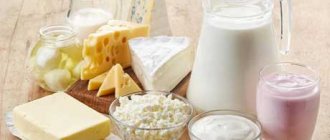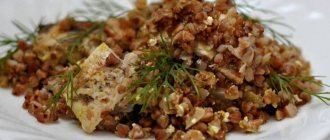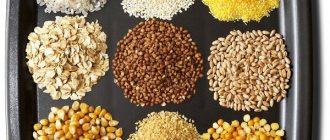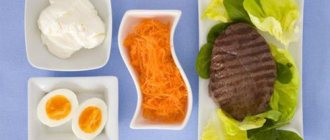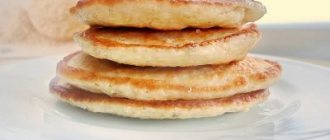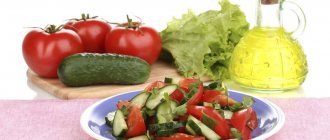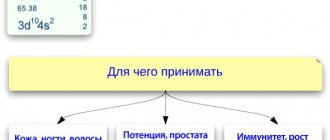What is the glycemic index
The glycemic index is a measure of how quickly or slowly carbohydrates break down into glucose. This index is measured on a 100-point scale. Accordingly, a product without carbohydrates will have a GI of 0 units. And the maximum GI value will be obtained by a product with a large amount of carbohydrates in its composition.
Those foods that have a high GI index are quickly absorbed by the body. The resulting energy is also quickly consumed. Low GI foods, on the contrary, are absorbed slowly and release energy gradually. This happens due to the large amount of fiber in their structure. Saturation from slow carbohydrates does not come as quickly as from fast ones. But the feeling of hunger is suppressed for a long time.
Simple carbohydrates are dangerous because they fill you only for a short time. Therefore, after eating, for example, a bun with sweet tea, you can quickly get hungry again. This occurs due to a sharp release of insulin into the blood. This is how the body reacts to a product with a high GI. Insulin is needed to process large amounts of sugar that enters the blood. In addition, it is responsible for storing fat “in reserve.” Hence the appearance of excess weight among sweet lovers.
Constant massive releases of insulin into the blood lead to another problem - metabolic disorders. And then we are talking not just about the negative impact of sweets on the elegance of the figure, but also about the health problems that they can cause.
The goal of every girl who wants to be beautiful and strives to lead a healthy lifestyle is to maintain a constant blood sugar level. If the body constantly experiences “spikes” in sugar, then it will have to store fat for future use. To prevent this from happening, study the list of low GI foods. It should be constantly in your memory, like a multiplication table.
How is glucose absorbed?
The breakdown of complex sugars to glucose (pictured) occurs due to the food enzyme amylase.
Most products, along with proteins and fats, contain carbohydrates, which are of two types:
- Simple carbohydrates or regular sugar are a water-soluble compound of glucose and fructose.
- Complex polysaccharides or starches are quite insidious and “not always sweet” substances.
The absorption of simple carbohydrates does not require additional enzyme participation. They quickly and independently break down into their components, but in order for starches to enter the bloodstream through the intestinal walls, they must be converted into glucose.
GI indicator by category
There are three levels of the glycemic index by which all foods are divided:
low – from 0 to 55; average – from 56 to 69; high – from 70 to 100.
Low GI foods
Such products are absorbed into the blood the slowest and give a feeling of fullness for a long time. But it’s difficult to get enough of them while eating. Therefore, in dietary nutrition they are supplemented with some products from the high GI category. The low GI group includes most vegetables, legumes, and fresh fruits (but not juices). Also included in this category are durum wheat pasta and brown rice.
Don't forget that low-carb foods have calories. Therefore, when drawing up a dietary schedule, it is necessary to take into account two parameters at once: the glycemic index and the number of calories of each ingredient .
Average GI level
This group includes some fruits and berries, such as apples, pears, plums, kiwi, blueberries, raspberries and others. This also includes black, rye and whole grain bread. There were also cereals: brown buckwheat, oatmeal, long-grain rice.
As you can see, neither group has meat, fish, eggs or poultry. The fact is that their glycemic index is practically zero. There are so few carbohydrates in them that they are not taken into account. When losing weight, it is important to combine protein foods and foods with a low glycemic value. This is the combination that is used during a protein diet. The effectiveness of this type of weight loss has been proven in practice many times.
High GI foods
These include: sweets, soft wheat pasta, bread and buns made from wheat flour, potatoes. There are also a lot of fast carbohydrates found in some cereals: white polished rice, pearl barley, semolina, as well as all instant cereals. You should not get carried away with too sweet fruits, berries and dried fruits, such as dates, pumpkin, figs, melon, pineapple.
You can find out which category certain products belong to using special tables, which we will consider below.
Beverages
| Product name | Glycemic index | Kcal | Squirrels | Fats | Carbohydrates | Product Rating |
| Pure still water | — | — | — | — | — | 5 |
| Green tea (no sugar) | — | 0,1 | — | — | — | 5 |
| Tomato juice | 15 | 18 | 1 | — | 3,5 | 4 |
| Carrot juice | 40 | 28 | 1,1 | 0,1 | 5,8 | 3 |
| Grapefruit juice (no sugar) | 48 | 33 | 0,3 | — | 8 | 3 |
| Apple juice (no sugar) | 40 | 44 | 0,5 | — | 9,1 | 3 |
| Orange juice (no sugar) | 40 | 54 | 0,7 | — | 12,8 | 3 |
| Pineapple juice (no sugar) | 46 | 53 | 0,4 | — | 13,4 | 3 |
| Grape juice (no sugar) | 48 | 56,4 | 0,3 | — | 13,8 | 3 |
| Dry red wine | 44 | 68 | 0,2 | — | 0,3 | 3 |
| Dry white wine | 44 | 66 | 0,1 | — | 0,6 | 2 |
| Kvass | 30 | 20,8 | 0,2 | — | 5 | 2 |
| Natural coffee (no sugar) | 52 | 1 | 0,1 | 0,1 | — | 2 |
| Cocoa with milk (no sugar) | 40 | 67 | 3,2 | 3,8 | 5,1 | 2 |
| Juice in packaging | 70 | 54 | 0,7 | — | 12,8 | 2 |
| Fruit compote (no sugar) | 60 | 60 | 0,8 | — | 14,2 | 2 |
| Dessert wine | 30 | 150 | 0,2 | — | 20 | 1 |
| Ground coffee | 42 | 58 | 0,7 | 1 | 11,2 | 1 |
| Carbonated drinks | 74 | 48 | — | — | 11,7 | 1 |
| Beer | 110 | 42 | 0,3 | — | 4,6 | 1 |
| Dry champagne | 46 | 88 | 0,2 | — | 5 | 1 |
| Gin and tonic | — | 63 | 0,2 | — | 0,2 | 1 |
| Liquor | 30 | 322 | — | — | 45 | 1 |
| Vodka | — | 233 | — | — | 0,1 | 1 |
| Cognac | — | 239 | — | — | 1,5 | 1 |
Return to content
Pros and cons of eating low and high GI foods
As already mentioned, low-carbohydrate foods with a lot of fiber are the most beneficial for a losing weight. A low GI does not cause sudden spikes in insulin. Accordingly, such food does not lead to the deposition of fat reserves. There are other advantages as well as disadvantages to foods with low glycemic value.
Pros of low GI foods:
No constant bouts of hunger. Due to fiber, carbohydrates are absorbed by the body more slowly. The feeling of fullness after lunch remains for a long time. Slow but effective weight loss. Thanks to zero or low index of nutritional ingredients, kilograms disappear for a long time. Feeling good, attractive appearance and excellent health. Effective prevention of obesity.
Disadvantages of Low GI Foods:
Physical weakness. Constant consumption of food with a low glycemic index leads to weakening of the body. He can no longer withstand the same physical exertion. Complex menu. Cooking using a table is not that difficult. It is much more difficult to correctly calculate the glycemic number and calorie content of foods when they are combined in one dish.
Foods with a high glycemic index also have advantages and disadvantages. The main disadvantage is the large amount of carbohydrates, which are quickly absorbed and cause health and weight problems.
Some people believe that fast carbohydrates damage your figure and should be completely excluded from your diet. But this opinion is wrong. It all depends on what the energy received by the body is used for.
Energy from high GI foods can be used in three different ways:
- Formation of deposits in reserve. It is in this case that fat folds are formed at the waist.
- Restoration of muscle function after physical activity. At the same time, glycogen reserves in the muscles are replenished.
- The use of energy for the functioning of the body at a given moment.
Naturally, in the first case, fast carbohydrates are the enemy of the figure. In the second and third - a necessary element for normal human life.
Products with a high index are harmful only in cases where they are consumed without measure or necessity. Uncontrolled consumption of buns, potatoes, and corn flakes can cause excess weight. But after sports or constant physical activity throughout the day, it is precisely these ingredients that can restore the body’s strength.
What does GI depend on and is it possible to influence it?
The index, set by nature itself, can change under the influence of various factors. The most important of them:
Structure
- . Cereals often contain starch. The higher its content, the higher the GI. For example, corn in this regard is the most “dangerous” of the grains. Due to the high amount of starch, its indicator reaches 65.
Heat treatment
- . The more vegetables are boiled, stewed or baked, the less benefits they bring. And the point is not only that vitamins and other useful microelements disappear from the composition. Under the influence of temperature, the glycemic number of potatoes, carrots and many other vegetables increases.
Presence of fats
- . If you add a little fat to your food, you can lower the GI. But it should be high-quality olive oil in small quantities. Omega-3 fatty acids have the same property. They are found in abundance in seafood and fish.
Presence of proteins
- . There is an opinion that the best “pair” for carbohydrates is proteins. By combining protein and carbohydrate foods, you can significantly reduce the GI value. But it is important to consider that carbohydrates in combination with some dairy products, which have
high insulin index
- , on the contrary, increase this indicator. The insulin index is another important indicator that shows the intensity of surges in glucose and insulin in the blood in relation to the glycemic index.
Presence of fiber
- . The higher the percentage of fiber content, the lower the glycemic number. Therefore, the diet must include fruits, green vegetables, herbs, bran bread, nuts, seeds and legumes.
Fraction
- . The finer the grain is chopped, the higher its carbohydrate content increases. The reason is simple: milled grains contain less fiber than whole grains.
Maturity
- . The riper the fruit, the higher its GI. The glycemic index of a green banana is lower than a ripe one. The same goes for any other fruit.
The glycemic number is not a constant value . The index of the same vegetable or fruit may differ. For example, the GI of raw carrots is 35 , and stewed carrots are 85 . For potatoes boiled in their jackets, this value will be lower than for mashed potatoes - 65 to 90 .
How to lower the GI of foods
- Cook pasta 'al dente'. That is, undercook them a little. The longer you cook them, the higher the GI will be.
- Choose slightly unripe fruits. Although they are not so sweet, they significantly reduce the risk of gaining weight.
- Eat fruits fresh. Squeezed juice increases the glycemic index.
- It is better to take regular rice, not polished. The best option is brown or wild.
All these rules can be generalized: the closer the product is to its natural form, the healthier it is.
When and who should eat low GI foods?
There are special diets based on the glycemic index. Nutritionists prescribe them in the following cases:
for diabetes or for its prevention; in cases where a person has problems with the absorption of insulin; for slow but effective weight loss; In case of metabolic failures, such a diet helps to improve metabolism.
The diet was originally developed for people with diabetes. And only then was it appreciated by those who watch their figure. The essence of this diet is to replace simple carbohydrates with complex ones. It is easy to distinguish carbohydrates from each other using special lists or tables. The result is a well-functioning metabolism, smooth sugar levels, weight loss.
Meat products
| Product name | Glycemic index | Kcal | Squirrels | Fats | Carbohydrates | Product Rating |
| Boiled chicken breast | — | 137 | 29,8 | 1,8 | — | 5 |
| Boiled veal | — | 134 | 27,8 | 3,1 | — | 5 |
| Boiled turkey | — | 195 | 23,7 | 10,4 | — | 4 |
| Boiled lean beef | — | 175 | 25,7 | 8,1 | — | 4 |
| Roasted rabbit | — | 212 | 28,7 | 10,8 | — | 4 |
| Stewed kidneys | — | 156 | 26,1 | 5,8 | — | 4 |
| Fried beef liver | 50 | 199 | 22,9 | 10,2 | 3,9 | 4 |
| Boiled beef tongue | — | 231 | 23,9 | 15 | — | 4 |
| Beef brains | — | 124 | 11,7 | 8,6 | — | 3 |
| Omelette | 49 | 210 | 14 | 15 | 2,1 | 3 |
| Fried chicken | — | 262 | 31,2 | 15,3 | — | 3 |
| Grilled pork | — | 280 | 19,9 | 22 | — | 3 |
| Boiled lamb | — | 293 | 21,9 | 22,6 | — | 3 |
| Beef Stroganoff | 56 | 207 | 16,6 | 13,1 | 5,7 | 2 |
| Pork cutlets | 50 | 262 | 11,7 | 19,6 | 9,6 | 2 |
| Sausages | 28 | 266 | 10,4 | 24 | 1,6 | 1 |
| Boiled sausage | 34 | 300 | 12 | 28 | 3 | 1 |
| Goose | — | 319 | 29,3 | 22,4 | — | 1 |
| Mutton | — | 300 | 24 | 25 | — | 1 |
| Roast duck | — | 407 | 23,2 | 34,8 | — | 1 |
| Fried pork | — | 407 | 17,7 | 37,4 | — | 1 |
Return to content
List of Low Glycemic Index Foods
This list includes products that contain complex carbohydrates. They break down slowly, do not provoke hunger pangs and help you lose weight. The following products have the lowest glycemic index:
Fruits and berries
- . Especially useful: blueberries, cranberries, blackberries, blueberries, lingonberries, cherries, raspberries, strawberries. The berries can be eaten fresh or frozen for winter use. This category also includes: grapefruit, apple, orange, pear, tangerine, as well as some dried fruits, for example, prunes and dried apricots.
Cereals, pasta, legumes
- . Of particular value are: wild or brown rice, green unground buckwheat, bran, 'al dente' pasta made from durum wheat. And also almost all legumes: chickpeas, soybeans, lentils, beans.
Vegetables
- . Green vegetables have the best qualities: white cabbage, cucumbers, broccoli, fresh green peas, green beans, sweet peppers. Other vegetables also boast lower indices: zucchini, eggplant, onions. Almost all greens also belong to this group: dill, parsley, spinach, celery. You can add mushrooms, ginger, carrots, asparagus, and rhubarb to this category.
Seeds and nuts
- . Hazelnuts, almonds, cashews, pistachios, walnuts and pine nuts have low glycemic indicators. Sesame and pumpkin seeds have the same beneficial characteristics.
Yogurt
- . It should be low-fat, without dyes, chemical additives and sugar.
Chocolate and ice cream
- . You can also afford sweets on a similar diet. But the chocolate must be bitter, and the ice cream must be made with fructose.
You can supplement the list with fish and meat, poultry and eggs. After all, they have a zero GI value. But meat and fish should be dry, without excess fat.
Low Glycemic Index Food Chart
The tables below show products whose GI is less than 55. The list mainly includes cereals, legumes, nuts, vegetables and fruits.
There was practically no place for sweets in it, with the exception of dark chocolate and fructose ice cream. Meat, fish, eggs and most dairy products are not included in the tables, since their GI is almost zero. Cereals and pasta
| The product's name | GI |
| red rice | 55 |
| brown rice | 50 |
| basmati rice | 50 |
| durum pasta | 50 |
| buckwheat | 50 |
| wholemeal bread | 45 |
| bulgur | 45 |
| durum pasta (al dente) | 40 |
| oat flakes (raw) | 40 |
| wild rice | 35 |
| quinoa | 35 |
| pearl barley | 30 |
| bran | 15 |
Vegetables, greens and legumes
| The product's name | GI |
| Sweet Potatoes | 50 |
| Red beans | 35 |
| Black beans | 35 |
| Chickpeas | 35 |
| White beans | 30 |
| Lentils | 30 |
| Tomatoes | 30 |
| Fresh beets | 30 |
| Garlic | 30 |
| Dried peas | 25 |
| Eggplant | 20 |
| Artichoke | 20 |
| Fresh carrots | 20 |
| Zucchini | 15 |
| Fresh peas | 15 |
| Broccoli | 15 |
| Spinach | 15 |
| Celery | 15 |
| White cabbage | 15 |
| Brussels sprouts | 15 |
| Cauliflower | 15 |
| Sweet pepper (Bulgarian) | 15 |
| Chilli | 15 |
| Radish | 15 |
| Cucumber | 15 |
| Asparagus | 15 |
| Ginger | 15 |
| Mushrooms | 15 |
| Green onion, onion | 15 |
| Olives | 15 |
| Rhubarb | 15 |
| Soybeans | 15 |
| Spinach | 15 |
| Avocado | 10 |
| Leaf lettuce | 10 |
| Parsley, basil, oregano | 5 |
Fruits and berries
| The product's name | GI |
| Banana | 55 |
| Persimmon | 50 |
| Kiwi | 50 |
| Mango | 50 |
| A pineapple | 50 |
| Dried figs | 50 |
| Grape | 45 |
| Grapefruit | 45 |
| Coconut | 45 |
| Cranberry | 45 |
| Cowberry | 45 |
| Dried apricots | 40 |
| Dried prunes | 40 |
| Fresh figs | 35 |
| Apple | 35 |
| Plum | 35 |
| Quince | 35 |
| Nectarine | 35 |
| Pomegranate | 35 |
| Peach | 35 |
| Apricot | 35 |
| Orange | 35 |
| Mandarin | 30 |
| Pear | 30 |
| Blueberry | 25 |
| Cherry | 25 |
| Raspberries, blackberries | 25 |
| Red currants | 25 |
| Strawberry wild-strawberry | 25 |
| Gooseberry | 25 |
| Lemon | 20 |
| Black currant | 15 |
Nuts and seeds
| The product's name | GI |
| Sunflower seeds | 35 |
| Poppy | 35 |
| Sesame | 35 |
| Pumpkin seeds | 25 |
| Cashew | 25 |
| Hazelnut | 25 |
| Peanut | 15 |
| Pistachios | 15 |
| Almond milk | 15 |
| Walnut | 15 |
Other
| The product's name | GI |
| Juices (no sugar) | 40-50 |
| Lactose (milk sugar) | 45 |
| Peanut butter (butter) | 40 |
| Coconut milk | 40 |
| Creamy ice cream with fructose | 35 |
| Yogurt (no sugar) | 35 |
| Soy milk | 30 |
| Almond milk | 30 |
| Chocolate (>70% cocoa) | 25 |
| Chocolate (>85% cocoa) | 20 |
| Cocoa powder | 20 |
| Fructose | 20 |
| Agave syrup | 15 |
| Tofu cheese | 15 |
You can download a table of low glycemic index foods in Excel here.
Fish and seafood
| Product name | Glycemic index | Kcal | Squirrels | Fats | Carbohydrates | Product Rating |
| Boiled cod | — | 76 | 17 | 0,7 | — | 5 |
| Boiled pike | — | 78 | 18 | 0,5 | — | 5 |
| Boiled crabs | — | 85 | 18,7 | 1,1 | — | 5 |
| Sea kale | 22 | 5 | 0,9 | 0,2 | 0,3 | 5 |
| Boiled hake | — | 86 | 16,6 | 2,2 | — | 5 |
| Boiled trout | — | 89 | 15,5 | 3 | — | 5 |
| Shrimps | — | 95 | 20 | 1,8 | — | 5 |
| Boiled oysters | — | 95 | 14 | 3 | — | 5 |
| Tuna in its own juice | — | 96 | 21 | 1 | — | 5 |
| Zander | — | 97 | 21,3 | 1,3 | — | 5 |
| Flounder | — | 105 | 18,2 | 2,3 | — | 5 |
| Boiled squid | — | 140 | 30,4 | 2,2 | — | 5 |
| Boiled crayfish | 5 | 97 | 20,3 | 1,3 | 1 | 5 |
| Boiled mullet | — | 115 | 19 | 4,3 | — | 4 |
| Pollock caviar | — | 131 | 28,4 | 1,9 | — | 4 |
| Beluga | — | 131 | 23,8 | 4 | — | 4 |
| Herring | — | 140 | 15,5 | 8,7 | — | 3 |
| Smoked cod | — | 111 | 23,3 | 0,9 | — | 3 |
| Hot smoked pink salmon | — | 161 | 23,2 | 7,6 | — | 3 |
| Fried perch | — | 158 | 19 | 8,9 | — | 3 |
| Fried carp | — | 196 | 18,3 | 11,6 | — | 3 |
| Boiled sardine | — | 178 | 20 | 10,8 | — | 3 |
| Boiled salmon | — | 210 | 16,3 | 15 | — | 2 |
| Red caviar | — | 261 | 31,6 | 13,8 | — | 2 |
| Cold smoked mackerel | — | 151 | 23,4 | 6,4 | — | 2 |
| Fish cutlets | 50 | 168 | 12,5 | 6 | 16,1 | 2 |
| Smoked eel | — | 363 | 17,7 | 32,4 | — | 1 |
| Crab sticks | 40 | 94 | 5 | 4,3 | 9,5 | 1 |
| Cod liver | — | 613 | 4,2 | 65,7 | — | 1 |
| Sardine in oil | — | 249 | 17,9 | 19,7 | — | 1 |
| Mackerel in oil | — | 278 | 13,1 | 25,1 | — | 1 |
| Saira in oil | — | 283 | 18,3 | 23,3 | — | 1 |
| Sprats in oil | — | 363 | 17,4 | 32,4 | — | 1 |
Return to content
Important facts about GI
To eat properly based on the glycemic index, you need to know a few important facts about it:
A double portion is inappropriate
- . Just because a food has a low GI doesn't mean it can be eaten in kilos. It is also necessary to take into account calorie content and composition. For example, potato chips have a lower glycemic index than green peas. But the latter has more benefits and nutritional properties.
Vegetables and fruits will be healthier if you eat them with the skin on.
- . And the point here is not only that vitamins and microelements are concentrated in the skin. An important role is played by fiber, which is found in abundance in the skin of the fruit. It can reduce GI significantly. Even new potatoes will become 2 times healthier if you wash them thoroughly, boil them in their skins, and then eat them without peeling them.
Different combinations of foods can lower or increase GI
- . For example, fiber, fat and acid (lemon juice) reduce the rate. The same effect can be achieved if you combine proteins with carbohydrates. And milk can increase the number due to the lactose (milk sugar) it contains.
Chewing thoroughly is important
- . If you chew food slowly, carbohydrates are absorbed more slowly. This is where the popular wisdom comes into play: “The longer you chew, the longer you live.”
The glycemic index is not the most important indicator when creating a diet. It is necessary to pay attention to the calorie content, as well as the nutritional value of foods. For example, foods with a low GI but high calorie content will promote weight loss. Conversely, a high glycemic index combined with a small amount of calories will lead to gaining extra pounds.
The total quantity of carbohydrates is more important than their quality. It doesn’t matter so much whether complex or simple carbohydrates are included in your diet. Much more important is the quantity in which they enter the body. For example, if you take durum pasta and cook it correctly, then too large a portion size can reduce all efforts to zero. After all, the total amount of carbohydrates will go off scale, despite the fact that they are “correct”.
Are low GI foods healthy and high GI foods harmful?
Foods with different GI values are beneficial for human health. It all depends on where and in what quantities the body spends the energy received from carbohydrates. The balance is disrupted when excess carbohydrates appear. If the body spends them usefully, then it will not have any problems with excess weight.
Eating foods with a high or medium glycemic number is beneficial only after increased physical activity, training, or hard work. Then such a diet is beneficial - it restores spent carbohydrates. In other cases, it is better to minimize the number of such products.
Low GI foods are beneficial for anyone who cares about their health. But in its pure form, such a diet can lead to weakness of the body. Therefore, it is better to supplement it with products with a medium or high index.
Remember that when you mix foods with a high and low glycemic index, you end up with an average.
Low glycemic diets provide maximum benefits:
people leading a sedentary lifestyle; patients diagnosed with diabetes mellitus; obese people suffering from obesity.
In these cases, a low GI diet will help keep your blood sugar levels in check. Also, such nutrition adjusts the metabolism and effectively reduces weight.
Difference between GI foods and diets
The glycemic index is determined for each food unit separately and reflects the rate of breakdown of carbohydrates with a subsequent increase in blood sugar. In practical dietetics, it is customary to distinguish between the GI of foods and the GI of the diet. In the glycemic index classification, there are 2 types.
| For food: | For diets: |
|
|
The diet is made up of several dishes, including a set of various food units with a certain GI indicator. The total glycemic index of the diet will be higher than that of individual foods.
This increase can be triggered by eating fruits, some berries or citrus fruits, as well as other foods that already have a GI of 55 or higher. When planning your diet, this factor must be taken into account.
For diabetics, a menu made up of various products should have a GI of 45 or lower (recommendation of the Glycemic Index Foundation). A low glycemic diet should be the goal of every diabetic.
This approach makes it possible to maintain blood glucose levels at optimal values, avoiding its sharp increase when eating. With this diet, the risk of developing diabetes complications is significantly reduced.

